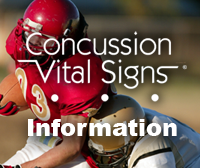
Overview
The diagnosis of acute concussion usually involves the assessment of a range of domains including clinical symptoms, physical signs, behavior, balance, sleep and cognition. Furthermore, a detailed concussion history is an important part of the evaluation both in the injured athlete and when conducting a pre-participation examination.
A patient suffering from a concussion can present with a myriad of symptoms which may include one or more of the following:
- Symptoms somatic (eg, headache), cognitive (eg, feeling like in a fog) and/or emotional symptoms (eg, lability)
- Physical Signs (eg, loss of consciousness,)
- Behavioral Changes (eg, irritability)
- Neurocognitive Impairment (eg, slowed motor speed, reaction times and memory problems)
- Sleep Disturbance (eg, somnolence)
Sports concussion experts recommend that if any one or more of these components is present, a concussion should be suspected and the appropriate management strategy instituted.
Concussion Vital Signs can assist with evaluating neurocognitive impairment as well as certain neurobehavioral manifestations.
Many schools and colleges are requiring athletes to take an assessment such as Concussion Vital Signs as part of the pre-season baseline testing and post-injury assessment return-to-play process. The Concussion Vital Signs Assessment modules (Baseline testing, post injury testing, concussion symptoms scale, self-reported concussion history) help evaluate whether an athlete has specific deficits in the clinical domains, e.g. symptoms, physical signs, behavior, sleep and cognition required for making an informed return-to-play decision.
Understanding the User Types--Administrator Users and Athlete Testing Users
It is very important you understand there are two types of user in the Concussion Vital Signs platform. Each has a discreet link on the home page. For example Administrator Users can see reports and perform tasks such as originating and monitoring Athlete user login information. An AdministratorUser cannot test. The Athlete Testing user or login is as you might expect from the name, where the athletes will enter the system to test. It is important the Administrator login be kept secure and not shared.
From time to time, the Administrative user should change or retire the Athlete Testing logins.
Any administrative information including lost password requests for either the Administrator user or Athlete Testing user will be sent to the Administrative User email of record as set during the registration process. If either the user name or the password of an Athlete Testing login is lost, the Administrative User of record as set during the registration process, will have to log in and make changes necessary to reactivate that Athlete Testing login.
Baseline Testing
Every athlete should be baseline tested with the Concussion Vital Signs battery to establish an individual neurocognitive baseline. Having this baseline allows athletic trainers and clinicians a frame of reference whereby an athlete's post-injury neurocognitive function can be compared to the baseline. The data from Concussion Vital Signs neurocognitive testing and symptom scales, along with other clinical endpoints, e.g. balance testing, history and physical, etc. is generally used when making a decision on the athlete's health status.
It is very important athletes produce "Valid" scores as indicated in the Valid Score section of the report. Should they not produce a valid score (a NO in the Valid Score column), they should be retested until they do. If they are unable to produce a valid score, consider referring the athlete to a qualified healthcare provider for a more comprehensive workup.
Post Injury Testing
When a concussion is suspected, you should refer to your approved concussion management protocol before administering a neurocognitive test. A Concussion Vital Signs post injury assessment may help clinicians evaluate the neurocognitive status of a concussed athlete during the recovery period. The Post Injury report will compare the baseline tests to any number of post injury tests so deficits from baseline can be easily noted. Concussion Vital Signs testing coupled with symptoms, history as well as balance testing may provide the clinician valuable information with which to assist in making return-to-play decisions.
Concussion Vital Signs testing alone in not evidence for returning to play. Clinicians should perform a comprehensive exam as needed. It is important to understand and for clinicians to be aware that athletes who do not do their best on the baseline test may score higher on a post injury test and this can be a spurious result.
Administering a Test
The athlete
Encourage the athlete to do their best. It is important the athlete should always do their best on the Concussion Vital Signs battery, and be honest and accurate on the concussion symptom rating scale and concussion history in order to obtain the best clinical data. The Valid Score, discussed earlier, will identify those that might not be performing their best.
Note that Concussion Vital Signs is a subset of the clinical battery CNS Vital Signs and as such may identify athletes with a cognitive deficit. Athletes with extremely low scores (Below Average in the “Compared to Peers” column on the report), that cannot improve upon retest may need to see a qualified healthcare provider for a more comprehensive workup..
The testing environment
Make sure the athlete is wearing there glasses or corrective lenses so they can see and read from the computer screen.
The athlete should be told the test will require about 30 minutes uninterrupted and to be sure they can sit for the entire test period at one sitting. Encourage them to visit the restroom before testing starts.
Check for any hand or arm injuries or seating challenges that might impede testing.
Make sure the testing environment is free from distraction. The scientific literature and common sense suggest testing fewer athletes at a time will foster a better testing environment.
Testing should NOT be attempted if the athlete is fatigued or distressed, or under the influence of drugs or alcohol.
Turn off all cell phones, PDA's, and other devices.
Emphasize the importance of reading the instructions prior to proceeding.
Remind the athletes if they DON'T give the testing their best effort (the test has embedded markers of valid effort, ie Validity Indicators) they may have to repeat the testing.
Close proctoring and small tests groups will provide a better test environment.
The technical environment
The testing facility must have a reliable, broadband network connection to accommodate the numbers of athletes being tested at one time.
In advance of testing, those administering the test should be certain the network will allow access to the website www.concussionvitalsigns as well as take a test.
If the test drags or skips tests you will need to reduce the number of athletes being tested or have the technical staff investigate the network.
If you attempt to log in more than 5 times with incorrect login credentials, an email will be sent to the administrative email of record with instruction to reset the password.
Starting the test from www.concussionvitalsigns.com
For both Baseline and Post Injury testing, from the home page www.ConcussionVital Signs.com, select Athlete Testing.
Then a user name and password for Athlete Testing login must be entered and following the prompts an athlete identifier. (It is suggested the battery login page be "pulled up" and displayed on the testing computer before the athletes take a seat to take the test. This will facilitate the testing process.).
The directions and test flow will be apparent and the athletes should not have any problems completing the test.
For the athlete to score their best they need to understand the following
- Try to pick a test time when you are well-rested, alert and clear minded
- Fully read and follow each set of instructions
- Ask the assessment administrator or proctor if there is anything the athlete does not understand
- Take the assessment, following the directions provided
- Athletes will be evaluated on the SPEED and ACCURACY of their responses
- The neurocognitive assessment is a test of brain function, NOT an IQ test
- It is very important that the athlete give their best BEST EFFORT!
At the conclusion of the testing, an account administrator can log in and view reports.
Copyright CNS Vital Signs, LLC. © 2003 - 2025 All rights reserved.
"Concussion Vital Signs" is a Trademark of CNS Vital Signs, LLC, All rights protected.
Use of Concussion Vital Signs Product and Website constitutes acceptance of the Concussion Vital Signs Terms of Use and the CNS Vital Signs Privacy Policy.

 Product Information
Product Information